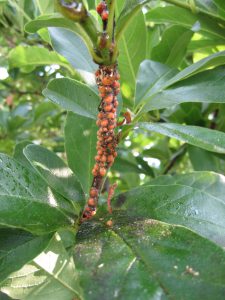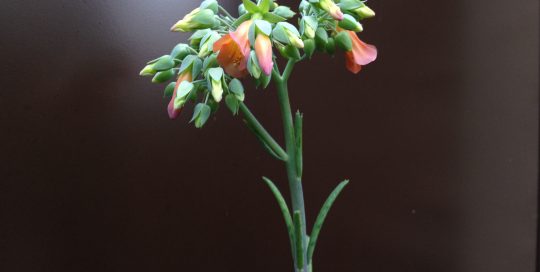Dealing with Scale Infestation
Views: 6473

I have an old braided trunk Schefflera tree that I rescued from the compost pile at my old job. For several years, I have tried to convince myself to leave it outside past the first frost of autumn. Then, I would no longer have to deal with this large, misshapen, scale-infested tree. As if letting nature freeze it to death somehow relieves me of responsibility! But, I can’t do it.
Every year, my guilty conscience takes over and I cram the Schefflera back through the door before temperatures drop below freezing. And then I fall, again, into my winter routine of constantly cleaning up the dropped leaves of my ugly Schefflera.
Soft Scale vs. Hard Scale
Then there’s the scale. There are hundreds of scale species, but I am most likely dealing with a soft scale. This is commonly called tuliptree scale. It spread from an infested Magnolia tree in my flower bed.
Most hard and soft scales look more like a bump than a bug. They’re distinguished by the type of protective shell they form over their bodies and whether or not they move while feeding. Both types pierce plant stems, leaves, and fruits with their straw-like mouths to feed on plant sap. Hard scales tend to be flatter, don’t move once mature, and don’t excrete much honeydew. Soft scales are generally more hump-shaped, slowly move while feeding (slow being the key word), and excrete large amounts of honeydew.
Honeydew is basically scale poop and makes leaves and surfaces under the plant sticky and often covered in sooty mold. Gross right?
Controlling
Controlling scale can be difficult, but with some persistence, it can be eradicated.
For light infestation, simply remove the insects by hand or prune out affected branches. For houseplants with heavier infestations, the easiest way to treat infested plants is to drench the soil with a systemic insecticide that contains imidacloprid or dinotefuran. The plant takes up the insecticide through its roots. The insects are killed as they feed on the insecticide-laced plant sap.
More consideration must be taken with outdoor plants to avoid injuring beneficial insects like parasitic wasps and predatory lady beetles. Hand removal is preferred if the scale infestation is light. For heavier infestations, horticultural oil is the next preferred method and is effective when applied in spring before bud break (dormant oil). It may also be applied at more diluted concentrations after plants have leafed out.
Never spray plants in bloom. Spraying foliage with harmful pesticides is not recommended since applications must be perfectly timed to the insects’ crawling stage, when it has yet to grow its protective shell. This is because the insecticide won’t penetrate the scale’s shell and you’re more likely to kill beneficial insects than the target pest.
Meet Abbi Hayes
Abbi's Recent Posts

Kalanchoe delagoensis: Mother of Millions







